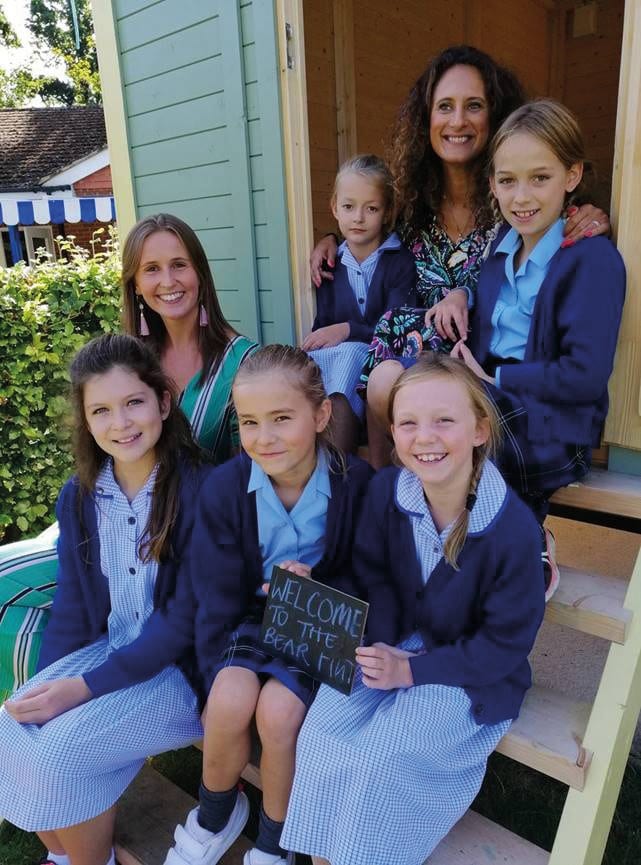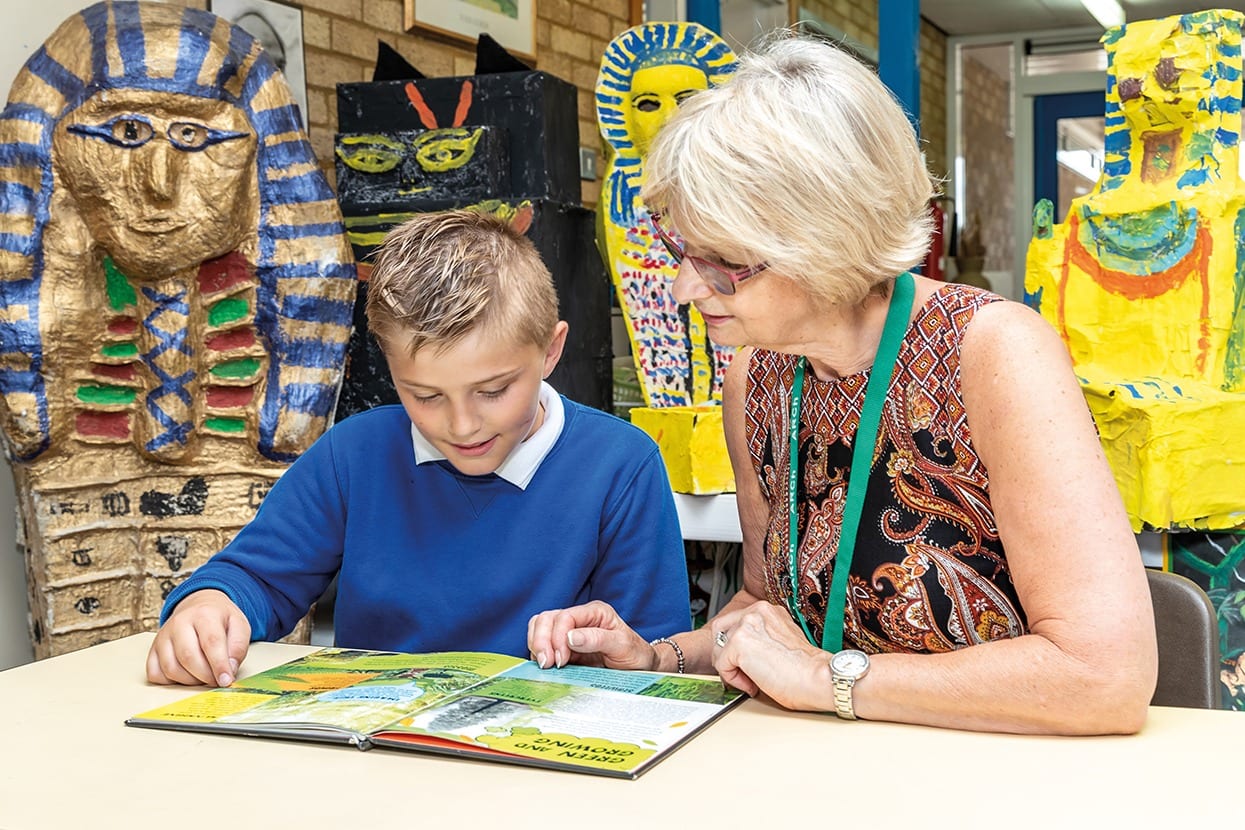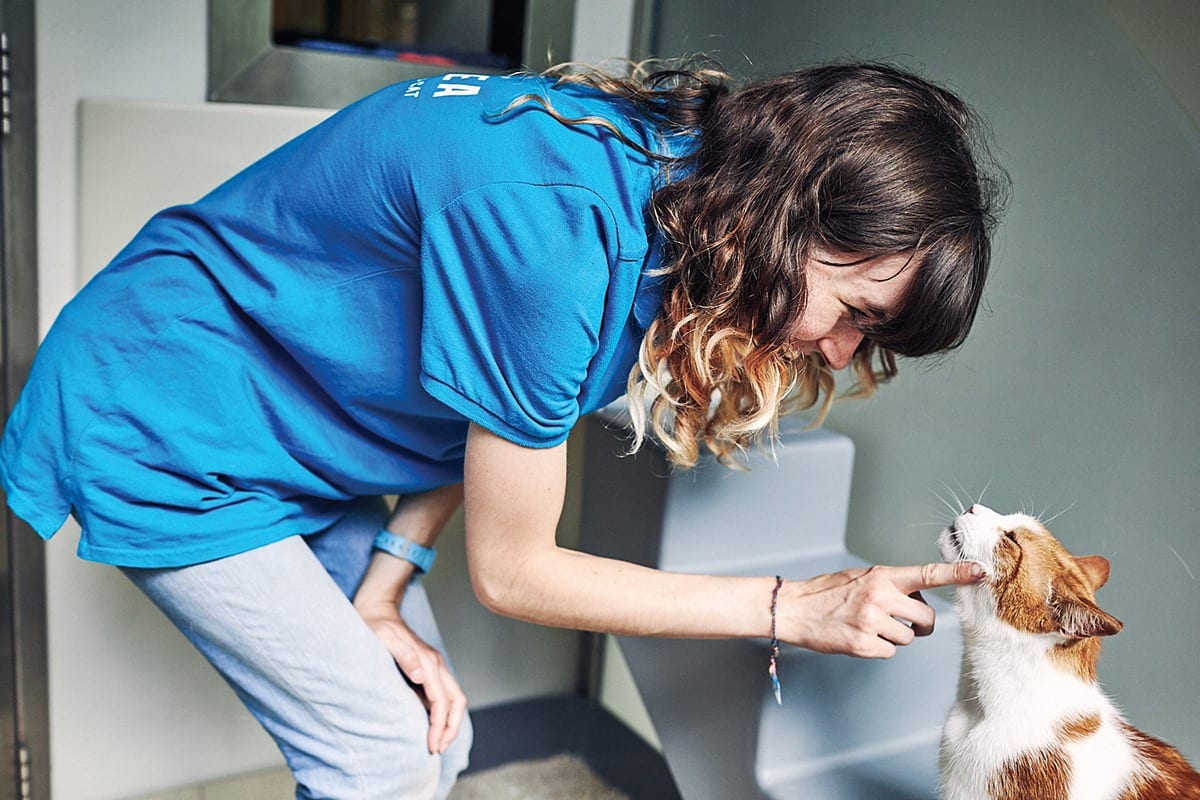Education guide: Winter 2020
Round & About
Featured
Welcome to the first education extra of 2020, we had an impressive array of entries for our story writing competition and they all prove what a talented bunch you are! Congratulations to our two winners and thanks to all who entered. Reading and writing are very good for your mental health and as more schools are focussing on pupils’ overall wellbeing we look at the importance of that and what is being done to improve this as Children’s Mental Health Week will be encouraging you to ‘Find Your Brave’
FIND YOUR BRAVE
Wellbeing is becoming as much a part of the curriculum as maths and English. Find out how it can help you and your school
Superheroes would probably feature highly for most children if they were asked who they thought was brave. However, bravery comes in all shapes and sizes as this year’s Children’s Mental Health Week is out to prove.
The week from 3rd to 9th February invites schools, youth groups, organisations and individuals to take part with one goal to “Find Your Brave”.
Bravery is about so much more than just fighting evil villains, it can be about fighting your own enemies, sharing worries and not being afraid to ask for help. Perhaps you want to try something new or push yourself outside your comfort zone, build your self confidence, improve your self-esteem and feel good about yourself.
Children’s mental health charity Place2Be which provides counselling and mental health support and training in schools, says bravery is all about finding positive ways to deal with things that may be difficult, overcoming physical and mental challenges and looking after yourself. They believe that children should not have to face mental health problems alone.
Place2Be launched the first Children’s Mental Health Week in 2015 to highlight the importance of children and young people’s mental health. Now in its sixth year, they hope to encourage more people than ever to get involved and spread the word. about the importance of caring for your mental health.
Last year, Place2Be worked with 639 schools in England, Scotland and Wales, reaching 364,080 children and young people. In the same year, more than 300 schools took part in Mental Health Champions programmes, equipping school leaders, teachers and staff with the skills and confidence to support pupils’ mental health. Over 1,600 child counsellors took part in training on various levels, building an ever-growing number who specialise in working with children and young people.
The Mental Health Foundation offers The 5 Ways to Wellbeing, a set of actions which have been proven to improve wellbeing, offering a starting point for schools.
Connect
Get to know your classmates, it’s a great support network, get together over activities or just tea and a chat.
Get active
Exercise can be good for your mind as well as your body, whether you cycle, dance, run, swim, jump or walk, it’s a great way to deal with negative thoughts and feelings.
Be mindful
Take time to check in with your thoughts and feelings, you may notice things you’ve missed, try a yoga session or mindfulness, breathing techniques can be a real help especially at exam time.
Keep learning
Lifelong learning is the way to keep the brain healthy, the sense of achievement from learning something new can be great for your mood, or try a quiz or a new skill.
Give to others
Helping others can help reduce your own stress, improve your own emotional wellbeing and even benefit your physical health.
• To find out more about how these charities can help you or your school, visit www.childrensmentalhealthweek.org.uk and
www.mentalhealth.org.uk
PASTORAL CARE – CAN YOU FEEL IT?
New headmaster of Barfield School in Farnham, Andrew Boyle talks about the importance of pastoral care for pupils
As a new Headmaster, my first half of term has been spent carefully observing and evaluating the many strengths of Barfield School, while also looking for those areas where a fresh pair of eyes might make a difference. One aspect of school life which works beautifully here is the understanding of what outstanding pastoral care looks like.
With research showing that mental health issues are becoming apparent earlier and earlier in children’s lives, is it any wonder that some parents are putting more emphasis on finding a school which places a higher priority on pastoral care and wellbeing?
From your first telephone conversation with the Admissions Registrar, you are immediately making judgements as to the ethos and values of the school and rightly so! However, it is my belief that pastoral care is best measured by ‘that feeling’ you get when you walk in through the front door for the first time.
The cornerstone of a culture of warmth, support and family comes from the people. There is simply no substitute for great staff and certainly no shortcut in the relationships they build with your children. Trust your first impressions, but if you are not sure, take a few moments to look around at the children, as they are always the best ambassadors of a school and its beliefs.
Outstanding pastoral care is not just the responsibility of the named Deputy Head or a policy document to which you refer to when something goes wrong, but it is in fact a commitment from top to bottom, with the understanding that everyone has a significant role to play. Cliche or not, happy children are going to make the most progress and will fulfil their potential in all aspects of school life.
I do not have the pleasure of having children yet, but when I do, top of my wish list will be to watch them skip into school every day, safe in the knowledge that when they do hit a road bump, the people around them know them inside and out.
STORY COMPETITION WINNERS
Our younger readers have proved to be a very talented imaginative bunch if the entries for our short story competition are anything to go by. We received a great variety of stories demonstrating there could well be some future David Walliams’ and J K Rowling’s out there. Well done to all who took part, here are the winning entries…

Keep Dreaming by Bethan Hopton
Bethan’s entry charmed us for the way she showed how small random acts of kindness can make all the difference, often in the most unexpected ways and how dreams can come true
Sam was cycling down a hill when all of a sudden…”STOP”. He looked behind him and saw an elderly man next to a road. “Little boy” he croaked “can you be a dear and help me across the road?” Sam flinched at the world little but he couldn’t help stopping his bike and going over to help the man.
He checked the road to see if there was any traffic. He was used to checking the road as he was twelve. He went out on his own all the time!
They walked across the road really slowly because it took ages for Sam to walk whilst carrying all of the man’s heavy bags. Sam checked his watch. He had been helping the man for almost five minutes and they were barely quarter of the way across the road!
Sam sighed as he thought of the football match he had intended to watch when he got home from school. It would be starting any minute!
“Did you have a good day at school?” the man asked in a suspiciously high voice. ”I guess,” murmured Sam.
Eventually, they got to the end of the road. “Bye,” Sam said and began to climb onto his bike. “Bye,” the old man called after him.
When he got home, Sam slumped onto the sofa and switched on the television. He groaned as he looked at the time. He had missed a whole half an hour of the game.
“Mum” he called ”can I have a drink?” ”Sure” she answered.
The next day at school started normally. Sam met his friends outside the gates and cast a cheeky grin at Ffion, his girlfriend who was standing outside the assembly hall when he got in.
Everybody was sat down when the head teacher entered. ”So,” she said, “we have a special guest today and I’ll let them introduce themselves.” She walked off the stage and an elderly man walked on. Sam instantly realised that the man was the same man that he had helped yesterday and smiled at him. “Hello,” the man said, peeling off a mask, “I am Harry Kane.”
Sam stared at Harry and gasped. He recognised him! “You will be pleased to know that I have chosen Sam Jeffers to be my mascot at our next game because of his kindness to elderlies. I disguised myself as an elderly man yesterday, waiting for someone to help me. Many people ignored me but Sam helped me even though he didn’t seem to particularly want to.”
Beeep! Sam’s alarm clock was beeping. ”Are you awake?” his mum called from downstairs. “Yes” Sam shouted back. He quickly got changed in the uniform that Harry had told him to wear and jumped in the car. They got to the stadium early so that Harry could go over things with him. Sam gasped “It’s amazing!” “I know” whispered Harry “Good luck!”

Turning over a new leaf by Elijah Mayers
Elijah’s use of description, painting pictures through words made it easy to visualise the story he was telling and again showed the value of being kind and thinking of others
Sam was cycling down the hill when all of a sudden, his mother appeared by the roadside with her hands firmly placed on her hips. He knew straight away that something was very wrong. Sam got off the bike and walked sheepishly with his head down towards his mum.
Sam’s mother Simone was a stout overweight woman who always wore clothes two sizes too small. Her face was as round and pale as the moon. Her eyes were cold and blue like the sea. Her black hair was long and thin like liquorice running down to her waist. Simone in her high-pitched voice shrieked at Sam to “Get in the house!!!”.
Sam made his way into the house and went straight into the living-room. The house was a mess and Dad lay spread out on the sofa fast asleep. Sam’s dad was a skinny man with a potbelly who loved to wear string-vests. He had thick Ginger hair covering his entire body, making him look like an orangutan. As he slept, Sam’s dad snored. In fact, he snored so loudly that the glass of water on the table next to him shook and eventually fell on the floor.
Ever since Sam’s dad had been sacked for stealing a pair of pink pyjamas from the warehouse where he worked, all he did was lay around the house snoring like a tractor.
Simone soon followed Sam into the living-room and scream at him “What have you done!!!”. Simone went on to explain that the Headmaster’s office had called her, and they wanted a meeting tomorrow.
“I can’t miss work and your dad is useless, so your grandad will have to go with you,” Simone yelled. A wave of fear spread over Sam and that night, he had a horrible nightmare about being told off by the Headmaster.
The next day, the doorbell rang as Sam was getting dressed for school. It was his grandad Jonas wearing a bright green suit and a blue tie shimmering in the sun. Sam sighed and let him in.
Later at school, the Headmaster’s secretary told them to wait in the Headmaster’s office. Sam was so worried that he started to feel nauseous. A moment later, a tall skinny man entered the room and introduced himself as Mr Pearce the Headmaster.
Mr Pearce explained that in the past, Sam had been in trouble a lot of times for bullying. Sam was known for Kicking, punching and pushing the smaller pupils in the school. Recently, Sam has changed his behaviour and now actually helps the other pupils when they hurt themselves. Mr Pearce went on to say how pleased he was that Sam had turned over a new leaf and made himself a better person. Sam nearly fell off his chair when Mr Pearce told him they had awarded him a commendation.
When Sam got home, he showed Simone the commendation and she was so pleased that she nearly fainted. From that day on, Sam’s mum stopped shrieking at him and started praising him instead.
THE HELP HUT
Pupils at Longacre School can enjoy a welcoming environment to talk in The Bear Hut
Schools are putting more emphasis now on pupils’ mindfulness and mental health, making sure their overall needs are addressed.
One of those which has been working to help children is Longacre School in Shamley Green which has opened a new wellbeing space.
The ‘Bear Hut’, so called after the bear that features in the school’s logo, opened at the start of the September term and is already proving popular.
Funded by Longacre PTA, the Bear Hut provides a safe, quiet, welcoming environment where children can be listened to. It will be used as a space for counselling, speech therapy and occupational therapy with individual children and small groups. Mindfulness Club and art therapy will also take place inside the hut.
The Bear Hut is the brainchild of Longacre’s Head of Art and Head of Years 5 & 6, Tara Pandey. She said: “Research has shown 70% of children and young people who have experienced a mental health problem have not had appropriate interventions at a sufficiently early age and that children and young people who experience mental illness are more likely than other people to experience mental illness in adulthood.*
“Creating the right environment for children is about creating the right physical environment as well as the right emotional environment.”
She said she expects it to be used as a place for teachers to meet parents and children together to talk through any issues and to offer reassurance or just share their day.
*according to research by Young Minds

HAPPY EATING
Honey Bees Day Care, Farnham has some advice to develop your child’s healthy eating habits

How your child eats today can have a huge impact on their health, food preferences and dietary habits. The earlier you begin teaching them healthy eating patterns, the more likely they’ll be to take these good habits with them into adolescence and adulthood.
Healthy eating can stabilise children’s energy, balance their moods and prevent illnesses. A balanced diet will also ensure your child gets the necessary vitamins, minerals and nutrients for growth and mental development.To get all these nutrients, it is important your littles ones start experimenting with a wide variety of foods from an early age – fruit and vegetables, beans, lentils, lean meat, oily fish, nuts, seeds and whole grains such as brown rice and bread.
A great way to get your children to experiment with food is to make it fun:
• get creative in the kitchen and let your child try different flavours and textures of food
• try and put different colours of food on the plate so they get a variety of nutrients, turn it inot a game with the colours
• get them involved in the weekly food shop, learn about where different foods come from
If they won’t try different foods, don’t worry: the majority of children go through phases with their eating, and habits will often change over time.
• Day care and forest school, Honey Bees, based in Bentley, near Farnham offers a full curriculum to get the most out of any child’s time in their care, including gymnastics, yoga and French
OUTSTANDING NURSERY
The Lime Tree Nursery in Alton is celebrating its top class report
A homely setting and an environment in which children flourish are just two of the reasons why Lime Tree Nursery in Alton has been rated outstanding.
The recent inspection revealed four areas in which Lime Tree was outstanding citing the “rich and stimulating activities” which support development and commented on the “exciting opportunities that skilfully prepares them for their future successes”.
There was also praise for the qualified and experienced staff, with the report saying: “They are always engaging with the children and make this a wonderful environment for the children to flourish.”
The report continues to say: “Children learn impressive new skills during forest school sessions, including how to use tools safely and how to cook food on open fires. The well-resourced outdoor area provides the children with various opportunities for exploration, risk taking and challenge.”
Relationships with parents were also highlighted. The report said: “They liken the nursery to a family and are delighted with their extremely supportive care.”
Lime Tree Children’s Day Nursery is set in a home from home, with an enclosed garden, full of nature to explore and with direct access to Anstey Park. Open for 51 weeks, from 8am – 6pm, taking children from birth to school age.
The nursery also welcomes children back during the school holidays for their first year of school, making the transition to school from nursery much easier.
THE POWER OF READING
Find out how ARCh can help

Reading for pleasure can increase self-esteem, reduce symptoms of depression, help build better relationships and reduce anxiety and stress. When immersing yourself in a good book, you can be swept away to a happy world, away from any dilemmas or stresses. Certain books can also help you realise you are not alone, which is often a focus for the healing process; recognising others may be going through similar struggles.
But what happens if you can’t read well? Assisted Reading for Children Oxfordshire (ARCh) has over 300 volunteers visiting primary schools twice a week to read with three children for 30 minutes each. Each volunteer has a box of books and games to engage with each child and they endeavour to find the right book to inspire a love of reading. An ARCh session focuses on the child improving their reading skills, but it’s about so much more; it’s about a special relationship helping that child gain confidence and knowing it’s OK to make mistakes.
The children and their adult volunteers benefit from the connection between reading and mental wellbeing. People who read into old age can reduce memory decline and have fewer physical signs of dementia. By sharing the magic of reading with a child, the volunteers can gain empathy and perspective at a time when their own connections may have reduced and a sense of loneliness may have crept in.
• To share the magic of reading and enhance your wellbeing in 2020 visit www.archoxfordshire.org.uk or call 01869 320380 to find out more. Happy reading!
IT’S ALL ABOUT THE QUESTION
Former head Gerald Vinestock has useful advice before you head off to a school open day

It’s easy enough to mock open days, but parents can find them useful. It’s important first to realise the school is selling itself and parents are potential customers; parents should forget their own schooldays terror of visits to the Head and ask the questions that matter.
If your Ermintrude is a budding Mozart, don’t reveal that until you have the answer to the question, ‘How important is music in the school?’ You are much more likely to get the answer you need than if you start by revealing that Ermintrude passed Grade 6 clarinet at the age of three.
Keep questions neutral therefore, but make sure you do ask them.
You may be shown round by a pupil – that is a good sign of the school’s confidence in its children – and you will be able to gauge a lot about the relationship between pupils and staff as you go round. You will pick up, even on an open day, something of the atmosphere of the school. That matters even more than exam results, though you should ask about these and where pupils go after leaving.
Classrooms are revealing and you should look at what’s on the walls, but remember that a rather untidy piece of writing pinned up prominently may reveal that here is a teacher who really cares: that particular piece of writing may mark a huge step forward for the pupil, whose confidence has now been boosted by public display of this work.
A visit on an open day can be helpful, but if you are close to choosing a school, a second visit on a normal school day will be even more helpful to enable you to gauge the atmosphere. Not all schools can cope with such individual visits, but it is worth asking, it will be easier to assess what the school is really like on a normal day and to ascertain whether this will be the right place for Ermintrude or Wilfred. Much more important than what gossip may say is whether you feel the school is right for your child. If you have met caring staff and happy children that matters more than local tittle-tattle when you come to make a very important decision.
The most important thing to remember is that however impressive and daunting the Head may be, ask the questions that are important for you and keep them neutral!
Gerald Vinestock was Northern Regional Director for the Independent Schools Information Service (Now ISC). He has recently had published Crib and the Labours of Hercules a children’s book available locally at Blackwell’s. Read more from Gerald Vinestock at www.geraldvinestock.co.uk
PUPIL POWER
Berkshire schools encouraged to enter conservation awards
School children in Berkshire are being invited to do their bit for the environment by taking part in the 2020 Dorothy Morley Conservation Awards in honour of a pioneering campaigner.
The awards are promoted by CPRE Berkshire and recognise the two best school projects promoting environmental conservation with prizes of £1,000 and £500 on offer.
CPRE Berkshire branch secretary Gloria Keene said they were encouraged by young people’s desire to change their local environment.
She said: “By promoting this award scheme throughout the county, we hope that we can help school children feel that they can really make a difference, particularly when news about the climate change emergency might feel overwhelming.

“We believe local action can bring big changes and look forward to hearing about pupils, teachers and parents working together on what we know will be some fantastic projects.”
Past examples of projects include tree planting and waste recycling, partnerships with organisations in towns and villages, promoting organic and local food, creating and developing school gardens and creating and maintaining wildlife friendly community areas.
The award reflects the work of Dorothy Morley who died in 1995 and was a strong campaigner on environmental issues. In addition to the £1,000 first prize and £500 for the runner up, all shortlisted schools are invited to display information about their project at CPRE Berkshire’s July presentation event.
The deadline for schools to register their interest is 31st January. For more information contact Gloria on 0118 930 6756 or email [email protected]
Go green!
Round & About
Featured
If we each make small changes to our lives we can collectively make a huge impact to protect our planet for future generations. Here are some positive ideas…
A new year, and a new decade. Recent months have delivered some very bleak news about the fate of our planet. We all know, thanks to Greta Thunberg and others, that urgent action is needed to mitigate the damage our species has done. However, we believe that positivity is the only way to bring about change so please consider these suggestions inspiration rather than guilt trips. Some of it might seem like common sense Together we can make a huge difference.
Tree’s company
Scientists have stated that billions more trees could remove two-thirds of all the carbon dioxide created by human activity. The Woodland Trust is the UK’s largest woodland conservation charity working hard to protect the 1,064 ancient woods threatened by development right now. Buy saplings or donate at www.woodlandtrust.org.uk. Also plant bee-friendly plants and wildflowers. And aim to use only naturally derived products and fertilisers and keep your lawn real rather than paving over.
Council care
In the garden, get a compost bin to reduce your household waste. Ensure you utilise food waste, green waste and recycling schemes in your area: local authorities are working very hard to boost these so do check online what can & can’t be recycled to reduce landfill. Reusing, and buying less in the first place is still the best way to lessen your carbon footprint. Monitor and aim to reduce your levels over time.
Shower power
Just 2.5% of the world’s water is freshwater (the rest being saltwater) and most of it is frozen or deep underground so we can’t afford to waste it. According to the Environment Agency, we could run short of water within the next 25 years. Shorten your shower and save 10 litres every minute, and get a water-saving shower head. An average five-minute shower will use 40% less water than a bath.

Feeling flush
Using the small button on your loo will save half the water. Or fit a low-cost water saving device in your cistern. Perhaps surprisingly, dishwashers use far less water and energy than washing up. Run taps slowly & turn off in between brushing your teeth, for example. In the garden, get a water butt if you can and use a watering can.
Heating help
When heating your home, turn radiators off or down in less used or unused rooms, consider if and when you really need the heating on and pop a jumper on or get a warmer duvet. Turning down your thermostat by just one degree can save up to £80 a year. Home boiler heating is responsible for nearly 20% of the UK’s greenhouse gas emissions.
Bright sparks
You can save electricity and around £30 a year just by remembering not leave your appliances on standby and more by unplugging. Don’t leave lights on or appliances and devices on, in standby mode or charging unnecessarily. Switch to more energy-efficient LED lightbulbs and save about £40 per year.
People power
Switch to renewable electricity and green gas at home and reduce both your carbon foorprint and bills. Leading providers include Bulb, Octopus Energy and Ecotricity. The average home can save 1.5 tonnes of CO2 from entering the atmosphere. Do install a Smart Meter too – visit www.uswitch.com
Holiday at home
Consider a UK staycation for your next holiday. A long-haul return flight, say to New York can generate 1,000KG of CO2 per passenger. It takes an average person in more than 50 of the world’s countries to reach that figure an an entire year. A flight to America’s west coast would produce 50% more emissions, and a flight to say China or Australia double that.

Web wise
Switch to using the Ecosia search engine, which commits 80% of its profits to supporting reforestation projects. To date, it’s helped to plant more than 70 million trees.
Shopping savvy
Shop more responsibly and you can significantly reduce your waste and recycling output. And “punish” major supermarkets for their inaction! Look for local suppliers of milk, bread, fruit and veg, meat and dairy and other products. Find products that are made or grown in the UK and use less packaging, such as loose fruit & veg. Sign up to Freegle updates and for clothing, join the kids & buy vintage on apps such as Depop.
Waste not
Think about switching to a disposable safety razor, a bamboo toothbrush, planet-friendly deodorant, bamboo loo roll, soap bars or refillable shampoos and shower gels and use a Mooncup if menstruating. More zero-waste shops & pop-ups are appearing: we will keep bringing you news of these locally!
Cleaning up
In the kitchen, consider green dishwasher and washing machine aids (from Ecoleaf to soap nuts), a household cleaner such as Koh, refillable washing up liquid and other products (from Splosh to Smol) and plastic-free cloths and scourers (from Ecococonut to Loofah).
Avoid palm oil
Research by Rainforest Rescue showed that the equivalent of 300 football fields are being destroyed every hour to produce palm oil production that can be found in close to 50% of the packaged products. The following ingredients on labels show that the product might well contain unsustainable palm oil: Palmate, Palmitate, Palmolein, Glyceryl, Stearate, Stearic Acid, Elaeis Guineensis, Palmitic Acid, Palm Stearine, Palmitoyl Oxostearamide, Palmitoyl Tetrapeptide-3, Sodium Laureth Sulfate, Sodium Lauryl Sulfate, Sodium Kernelate, Sodium Palm Kernelate, Sodium Lauryl Lactylate/Sulphate, Hyrated Palm Glycerides, Etyl Palmitate, Octyl Palmitate and Palmityl Alcohol. (Source: WWF)
Drinking problem
It goes without saying that if you’re a keen coffee drinker or like to carry a drink on your travels, you should invest in a reusable coffee cup (from R Cup to Stojo) and drinks bottle (from Klean Kanteen and Jedz to One Green Bottle).
Food for thought
Avoid food waste and cut your household emissions by controlling portions, planning meals and monitoring dates. Every year in the UK we throw away £13 billion worth of food that could’ve been eaten, with the average wasting £500 a year. See our Ramblings for a wealth of gardening clubs to help you grow your own or share the fruits of other labours in various swap sales in your community.
A golden example of dining
Liz Nicholls
Featured
Liz Nicholls reviews the newly opened Ivy Oxford Brasserie.
In these strange, straitened times, luxury feels like it’s in short supply. In fact, “luxury” has become so rare a concept that it feels a retro, almost naughty. Luckily, the energetic team behind The Ivy Oxford Brasserie haven’t received this particular memo.
From the moment we were ushered inside, off the bleak wintry high street into the velvet-coccoon of the cloakroom we were (to quote Beyoncé) living lavish.
The Ivy Oxford Brasserie’s arrival in this often austere city of broken dreams has caused a big fat buzz for good reason. Because we’re all hungry for some luxury, and a place to celebrate rather than commiserate.
As with its celebrity honeypot mother branch in London, and the successful brasserie outposts in Winchester and Marlow, the Ivy brand is all about the best of the best. That’s most thrilling, on first entry, with the service. The staff offer the level of old-fashioned courtesy and enthusiasm that makes you feel like you’re winning at life. I go weak at the knees for a good banquette (especially a curvy orange one) and the effervescent Karim’s recommendation – truffle arancini – were balls of richly flavoured sexy joy; the perfect accompaniment for Magdalen Manhattan.
You can’t visit this Ivy branch without being wowed by its interior. Instagram has helped to gild the Ivy Oxford’s golden age because it really is a maximalist wonderland that feels designed to be snapped. For Pinterest fans like myself, the general vibe could be defined as “1920s Flapper Luxe”, with huge botanical motifs (toucans, butterflies, rainbow trout) and shiny surfaces at every turn. The old bank’s stately dimensions make it the perfect stomping ground for anyone in need of a bit of glam – even strutting up the copper-hued illuminated staircase to the ladies makes you feel special. The toilets themselves (which you might have seen on Insta) are worth special mention: rose quartz sinks, brass taps, gothic-gold floral wallpaper and jewel-hued pouffes… No wonder, then, that the smallest rooms have apparently been papped even more than the chocolate bombe (which comes a close second). And the enamel-ceilinged private hire party room is a golden example of how to create a setting where you can and should celebrate in debauched yet elegant style, a la the Ivy alma mater.

Hype can really detract from a good meal, and I had thought this Ivy outpost might be more style over substance but happily I was proved wrong. Tempura prawns and salt & pepper squid, in their conical silver salver, were crisp and gorgeous dunked in their wasabi and miso dressing and – a greedy choice – the lobster risotto was a divine creation of sweet meaty flesh doused in a seafoamy bisque dressing with a perfect partner of tender samphire.
Another greedy winter choice (and Karim’s recommendation), chicken Milanese was peak pleasure, coated in brioche crumb but kept savoury by a shiny tureen of truffle cream sauce that I kept trying to steal and topped with a rudely perfect fried egg. Then, as if to prove more definitely is more, the blackened cod fillet. This has almost become a cliché dish, which footballers plump for at Nobu and other top-tier celeb haunts, but technically the Ivy version is very hard to fault: pearly succulent fish, baked in a banana leaf beautifully fragrant with sesame and helped to sing with its citrus-pickled fennel (genius) broccoli and yuzu mayonnaise. Top marks too for a sublime sweet potato side and creamed spinach with pine nuts. All of it looked beautiful but tasted even better.
That much-Instagrammed chocolate bombe is also worth its 15 minutes: a grenade of golden flavour whose honeycomb centre oozed out to mingle with the vanilla ice cream once the hot sauce was poured on top to make a big sticky mess.
With all this glitz & glam, you’d expect the Ivy to be expensive but it’s reasonable: a la carte starters hover about the £10 mark, mains around £20 and there’s a three-course set menu for £21 which is stunning value, all things considered.
Hats off to the Ivy team. They’ve managed to live up to the not-inconsiderable hype. From my grandmother – who toasted her 94th birthday here earlier this month – to youngsters in athleisure chinking drinks at the bar, being made to feel like royalty is surely the best measure of success.
Oh yes it is…
Round & About
Featured
Pantomimes are many children’s first experience of the theatre and what a way to start!
Dashing heroes, beautiful heroines and villains you can boo and hiss at, they really are great family fun for all. Karen Neville offers up our guide to some of the star-studded highlights and those on the local stages…
CHOOSE YOUR AREA:
We have gift off!
Round & About
Featured
‘Tis the season…
Round & About
Featured
Christmas is approaching and, ahead of advent, we thought that now would be a good time to suggest some great places across our large & thriving readership areas for a tipple, a bite or for presents.
So stop and enjoy a festive drink or a winter warmer meal, perhaps as a breather while you’re out shopping or else for a date or catch-up with friends. Those who work in our food & drink industry will tell you that it’s hard work and local stars deserve our recognition. Share your favourites, too in the comments below.
CHOOSE YOUR AREA:
DOGLE 2019
Round & About
Featured
Photo: Sophie and her puppy, Alan Smith, overlooking the Col De L’Iseran in France in the summer – Alan will be walking the final stage of the challenge with Sophie
Oxfordshire adventurer Sophie Rooney is three days into an incredible 1,000-mile challenge.
On Thursday 26th she began an endurance event, DOGLE, which covers the length of Britain in 30 days, finishing on 26th October, broken down into 10 stages – each stage being completed in a different sporting discipline.
Sophie from Bodicote will be joined by fellow adventurers on each of the stages, many of them incredible athletes in their own right.
And she’s doing it all to raise funds for IAPWA (The International Aid for the Protection and Welfare of Animals) which was founded in 2009 to protect and improve the welfare of animals in need.
Sophie’s incredible challenge involves:
STAGE 1
John O’Groats to Inverness
Gravel biking
150 miles in 3 days
STAGE 2
Inverness to Fort William
Kayaking
60 miles in 2 days
STAGE 3
Fort William to Milngavie
Running
96 miles in 4 days
STAGE 4
Milngavie to Ambleside
Cycling
126 miles in 2 days
STAGE 5
Lake Windermere
Swim
11 miles in 1 day
STAGE 6
River Levern
White water raft
4 miles in 1 day
STAGE 7
Haverthwaite to Prestatyn
Cycling
129 miles in 1 day
STAGE 8
Prestatyn to Chepstow (Offa’s Dyke)
Running
177 miles in 7 days
STAGE 9
Chepstow to St Just
Scooting
239 miles in 8 days
STAGE 10
St Just to Land’s End
Dog walking
8 miles in 1 day
Marianne Beggs, fundraising and communications at IAPWA, said: “We are very grateful that Sophie is attempting this incredible endurance event. Money raised from the event will ensure many animals in need have access to vital treatment and support through our projects.”
Second chances
Round & About
Featured
For 159 years, Battersea Dogs & Cats Home has rescued and rehomed lost, abandoned, neglected and unwanted pets that, through no fault of their own, have found themselves in desperate need of a second chance.

Since it was founded in 1860, Battersea has helped over three million dogs and cats to find new loving homes or be reunited with their original owners after going astray. But Battersea is not just a rescue charity. Our work stretches beyond our centres through our position as a driver for change and a champion for vulnerable animals. In the last decade alone, we have worked to bring about key changes in the law, such as increased sentences for animal cruelty, and we are recognised for our positive approach to partnership working and sector-wide collaborations.
Across our three sites – Battersea London, Brands Hatch, and Old Windsor – we help over 7,000 dogs and cats every year. Some have been given up when their owners can no longer care for them. Some have been abandoned and found wandering the streets.
Battersea’s promise to these frightened, often neglected animals is to never turn them away.
We aim to never turn away a dog or cat in need of help, caring for them until their owners or loving new homes can be found, no matter how long it takes. We are champions for, and supporters of, vulnerable dogs and cats, determined to create lasting changes for animals in our society.
In 2018, Battersea rehomed on average 6 dogs and 6 cats every day. For our staff and volunteers, there’s nothing better than seeing our animals setting off for their new life.
Our Values
Everything we do as individuals and teams, as vets and volunteers, nurses, kennel and rehoming staff, fundraisers and foster carers is underpinned by Battersea’s Values.
Care: We are passionate about the welfare of dogs and cats, and all our work is inspired by the needs of, and our love for, animals.
Excellence: We have been working tirelessly to provide shelter for animals for over 150 years. We are one of the oldest animal charities in the world and the knowledge and experience we have gained has made us credible leaders in our field.
Determination: We deal with some of the most challenging situations that impact the lives of dogs and cats. We seek to tackle problems at source by working actively with communities and wider society, challenging misconceptions and encouraging owners to take responsibility for their pets and treat animals humanely. We will not shy away from difficult issues.
Respect: We treat all animals and people with respect and dignity.
Integrity: We are trustworthy, we are indebted to our supporters and greatly value all the donations given to us, ensuring that they are carefully spent on providing the best possible future for animals.
Commitment: We strive to find every dog and cat a loving home. We put no limit on the time an animal stays with us, and we will never put an animal to sleep unless significant medical, safety, or legal reasons compel us to do so. Our staff and volunteers are hugely committed.
Our Reach
Battersea’s respected, authoritative and influential voice has a proven record in bringing about policy and legislative change to benefit animal welfare, and 2018 was no exception.
We had a wide range of successes, all aimed at improving the health and welfare of animals that cannot speak for themselves. These successes included; influencing Government to support a ban on third party sales and having various asks from our Backstreet Breeding campaign included in the regulations for breeding and sale provisions, resulting in closure of the loophole that previously allowed sales of puppies under eight weeks.
How You Can Help
Without the support of our incredible staff, volunteers and supporters, Battersea would not be able to continue all the hard work we do to help dogs and cats.
In 2018, over 1,000 volunteers and foster carers donated almost 150,000 hours to Battersea, across all three centres, assisting our staff in a huge variety of ways. As well as our ever-popular animal welfare roles, volunteers help staff with office duties, represent us at events, show visitors around our centres and help us raise vital funds. We are also supported by a team of community engagement volunteers who go into local schools to educate children about our cause and responsible pet ownership.
Our volunteers can feel good about giving back to the community and helping dogs and cats that may not have had the best start in life. They gain new and transferable skills as well as developing current ones and many will use their experiences with us to enhance their CVs or even make a full career change.
It’s also a great way to make lots of new two-legged and four-legged friends!

Headlines & Hedgerows
Round & About
Featured
Our countryside & its wildlife is at risk. We encourage you to join the campaign to save our endangered hedgerows and share an exclusive extract from John Craven’s new book.
The hedgerows that criss-cross our countryside are not only an iconic sight, but a vital habitat and corridor for many of our native species. However, they are becoming increasingly fragmented which is threatening the wildlife that depends on them.
We’ve lost about half our hedgerows since WWII. Although the rate of direct hedge removal has been reduced, hedgerows are being lost simply through how they are managed.
“With 70% of UK land being agricultural, hedgerows offer the safest route for wildlife to travel across farmland,” says Megan Gimber, key habitats project officer at PTES. “Sadly, many hedgerows are becoming ‘gappy’, which fragments this amazing network. And, without more sensitive management, many hedgerows are at risk of being lost altogether. This is problematic, especially when we’re seeing a fall in numbers of the animals that depend on them, such as hedgehogs, bats, hazel dormice and song thrush.”
In Britain, habitat fragmentation is thought to be a limiting factor for the distribution of some species and a threat to others’ survival. Corridors play a vital role preserving a number of species deemed ‘at risk’. Some 16 out of the 19 birds included in the Farmland Bird Index, used by government to assess the state of farmland wildlife, are associated with hedgerows.
Healthy hedgerows reduce soil erosion, flooding damage and air and water pollution. They provide forage for pollinating insects, predators to keep crop pests in check and shelter for livestock, reducing deaths from exposure and improving milk yields. Hedges help us fight climate change by storing carbon and reduce the damage from flooding.
To take part in the Great British Hedgerow Survey or find out more, visit hedgerowsurvey.ptes.org


An extract from John Craven’s new book

Headlines and Hedgerows is published by Michael Joseph
We have all heard that well-known piece of advice first coined by W.C. Fields: “Never work with animals or children.” Well, I’ve done both throughout my career (in fact, I couldn’t have succeeded without them!) so in my case at least that old adage is totally wrong.
I suppose one reason for my longevity is that I have never been very ambitious. I have not sought the headlines, never seriously courted celebrity nor been tempted to take chances on high-profile but potentially risky and short-lived programmes – apart from one, and that was Newsround, which was a six-week experiment in 1972. Thankfully it is still going strong so, as it turned out, it was not much of a gamble and a recent poll in Radio Times placed Newsround at number three in a list of the top 20 children’s programmes of all time.
And Countryfile is often in the top 20 of most-watched shows. During my 30 years there I’ve seen rural issues ranging from social isolation and deprivation to the way our food is produced climb higher and higher up the national agenda. That our audience is split pretty evenly between country dwellers and townies proves to me that, united as a nation in this at least, we want to preserve, protect and enjoy our glorious countryside…
For my Countryfile interview with Prime Minister David Cameron, we met for an hour at Cogges Manor Farm, a rural heritage centre in his Oxfordshire constituency. The cameras were set up around the kitchen table and before he arrived a lady who seemed to be in charge of his “image” wanted to know where he’d sit. She checked the angles and saw a large Welsh dresser in the background. “Could we move some of those plates and ornaments,” she said. “It’s too fussy.” It proved that politicians have learned to be careful what’s behind them on screen. An exit sign, for instance, would be the last thing they wanted.
When Mr Cameron came in, dressed casually in a jumper – this, after all, was Countryfile – he said “I was brought up on you, John!” I don’t feel particularly old but it’s alarming when the man leading the country says you were part of his childhood! We had a wide-ranging conversation and he had no idea of the questions beforehand. I challenged him on his plan to make his administration the greenest government ever (which didn’t really happen) and overdevelopment threats to the landscape. “I care deeply about our countryside and environment,” he told me earnestly. “I’d no more put them at risk than I would my own family.”
Today, I wonder what he’d make of the report by the Campaign to Protect Rural England revealing 15,500 new houses have been approved in areas of outstanding natural beauty in the years since. We also talked of his plans for a free vote in Parliament on bringing back hunting with hounds (which never happened) and persuading all other EU countries to enforce farm animal welfare laws as diligently as the UK (still waiting for that). I was impressed by his detailed knowledge of rural issues, even when pressed for details. A few months later at a Downing Street lunch for people involved in all aspects of the countryside, he smiled and said he hadn’t expected to be grilled by “a rural Jeremy Paxman.”






























